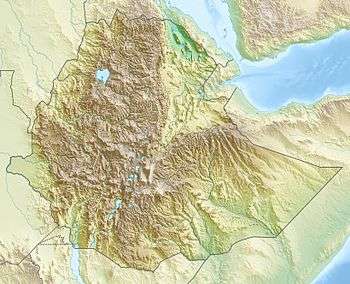Amba Alagi
| Amba Alagi | |
|---|---|
 Alagi Amba, near Attala. Photograph taken by 10th Company, RE | |
| Highest point | |
| Elevation | 3,438 m (11,280 ft) |
| Coordinates | 12°59′39″N 39°30′13″E / 12.99417°N 39.50361°ECoordinates: 12°59′39″N 39°30′13″E / 12.99417°N 39.50361°E |
| Geography | |
 Amba Alagi Location in Ethiopia | |
| Location | Debubawi (Southern) Zone, Tigray Region, Ethiopia |
Amba Alagi is a mountain, or an amba, in northern Ethiopia. Located in the Debubawi Zone of the Tigray Region, Amba Alagi dominates the roadway that runs past it from the city of Mek'ele south to Maychew. Because of its strategic location, Amba Alagi has been the location of several battles. The Battle of Amba Alagi was the first in a series of battles between General Baratieri and Emperor Menelik during the First Italo-Ethiopian War. As Anthony Mockler describes it,
- It was [a] real amba, flat-topped, covered with crevices and canyons and caves, impregnable on the north and north-east where the Tug Gabat ran round its flanks through precipitous ravines, falling steeply away in the rear to the spur of Antalo, behind which lay the broad plain of Mahera.[1]
History
The first mention of Amba Alagi is in the Chronicle of Emperor Baeda Maryam (1468–1478 AD), who personally led an expedition against the Dobe'a, who lived around Amba Alagi and raided the caravan routes. In the early 19th century, Ras Wolde Selassie controlled the amba, and used it on 18 August 1811 to imprison Gebre Guro, the brother of Sabagadis, for 18 months because he had rebelled against the Ras.[2] The road built from the coast south to Magdala during the British 1868 Expedition to Abyssinia passed through Amba Alagi.[3] A generation later, the mountain was the scene of a battle in February 1889 between Ras Alula Engida and Ras Seyoum Gebre in which Alula was wounded.[4]
First Battle of Amba Alagi
The first Battle of Amba Alagi occurred in December 1895. On December 7, the Ethiopians defeated an Italian army of 2,350 led by Pietro Toselli and a day later, on December 8, the Ethiopian emperor, Menelik II, drove out the Italian forces of General Oreste Baratieri. After the defeat, the Italians withdrew from Amba Alagi and Gondar to their half-finished fort at Mek'ele, which Menelik then besieged for 15 days (6–21 January 1896).[5]
Second Battle of Amba Alagi
The second Battle of Amba Alagi was fought in May 1941, during World War II, part of the East African Campaign. The mountain had galleries carved into the rock to protect the defending troops and hold ample ammunition and stores. The defenders, Italian troops under command of the Viceroy, the Duke of Aosta, thought themselves to be impregnable. The initial attacks on the approaches to Amba Alagi by British troops under Major-General Mayne from the north, commenced on May 4 with a pincer from the eastern and western sides. There was hard fighting in the jagged mountainous terrain. Mayne's troops were joined on May 12 by Brigadier Dan Pienaar's 1st South African Brigade, which had captured the Italian garrison of Dessie (April 20) located 200 miles south of Amba Alagi, and by May 14 Amba Alagi was completely surrounded. A final assault was planned for the next day but a lucky strike by an artillery shell hit an Italian fuel dump, sending a stream of oil into their last remaining drinking water and forcing the garrison's surrender.[6]
The film La Pattuglia dell'Amba Alagi, shot in 1953 by Flavio Calzavara, glorifies the Italian defense against the British.
Third Battle of Amba Alagi
In 1943, Amba Alagi was the location of the decisive battle of the "Woyane Rebellion" in Enderta Province. After capturing Mek'ele, the Woyane rebels swept south to the mountain where they encountered a government force consisting of 2,000 regular soldiers and 8,000 territorials. From 18 September through 6 October 1943, rebels under the personal leadership of Blatta Haile Mariam Redda repeatedly stormed the government positions, until artillery barrages and British Blenheim bombers at last dispersed the rebels.[7]
Notes
- ↑ Anthony Mockler, Haile Selassie's War (New York: Olive Branch Press, 2003), p. 97.
- ↑ Nathaniel Pearce, (J.J. Halls, editor), The Life and Adventures of Nathaniel Pearce (London, 1831), vol. 1 p. 88
- ↑ C. R. Markham, "Geographical Results of the Abyssinian Expedition", Journal of the Royal Geographical Society, 38 (1868), p. 37
- ↑ "Local History in Ethiopia" The Nordic Africa Institute website (accessed 3 January 2008)
- ↑ The 1895 battle at Amba Alagi is described by Chris Prouty, Empress Taytu and Menilek II: Ethiopia 1883-1910 (Trenton: Red Sea Press, 1986), pp. 140-3.
- ↑ Compton Mackenzie, Eastern Epic, pp. 67-70
- ↑ Gebru Tareke, Ethiopia: Power and protest (Lawrenceville: Red Sea Press, 1996) pp. 109-113
References
- Mackenzie, Compton (1951). Eastern Epic: September 1939 – March 1943 Defence. I. London: Chatto & Windus. OCLC 59637091.
External links
- Battle of Amba-Alagi on December 7
- Battle of Amba-Alagi on December 8
- Timeweb - Amba-Alagi
- La Pattuglia dell'Amba Alagi (1953)
- Amba Alagi